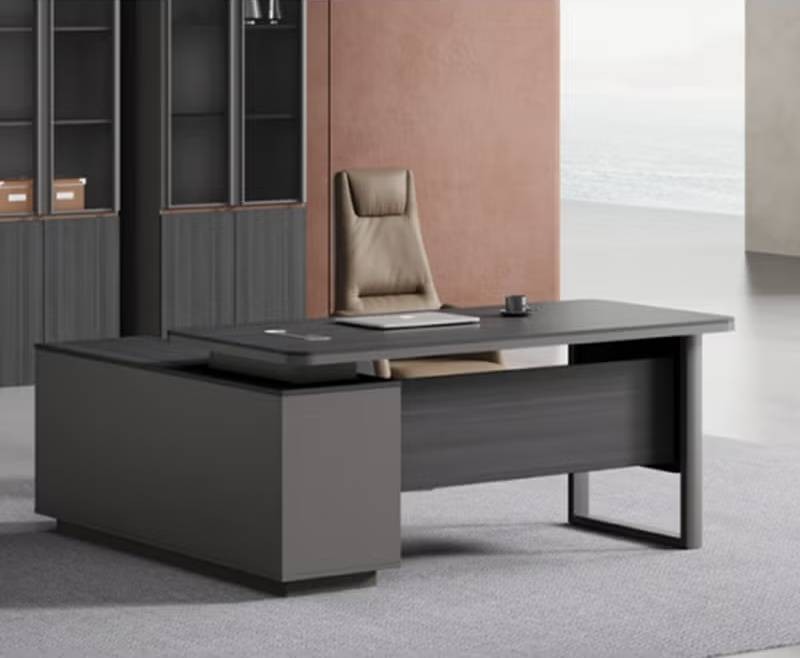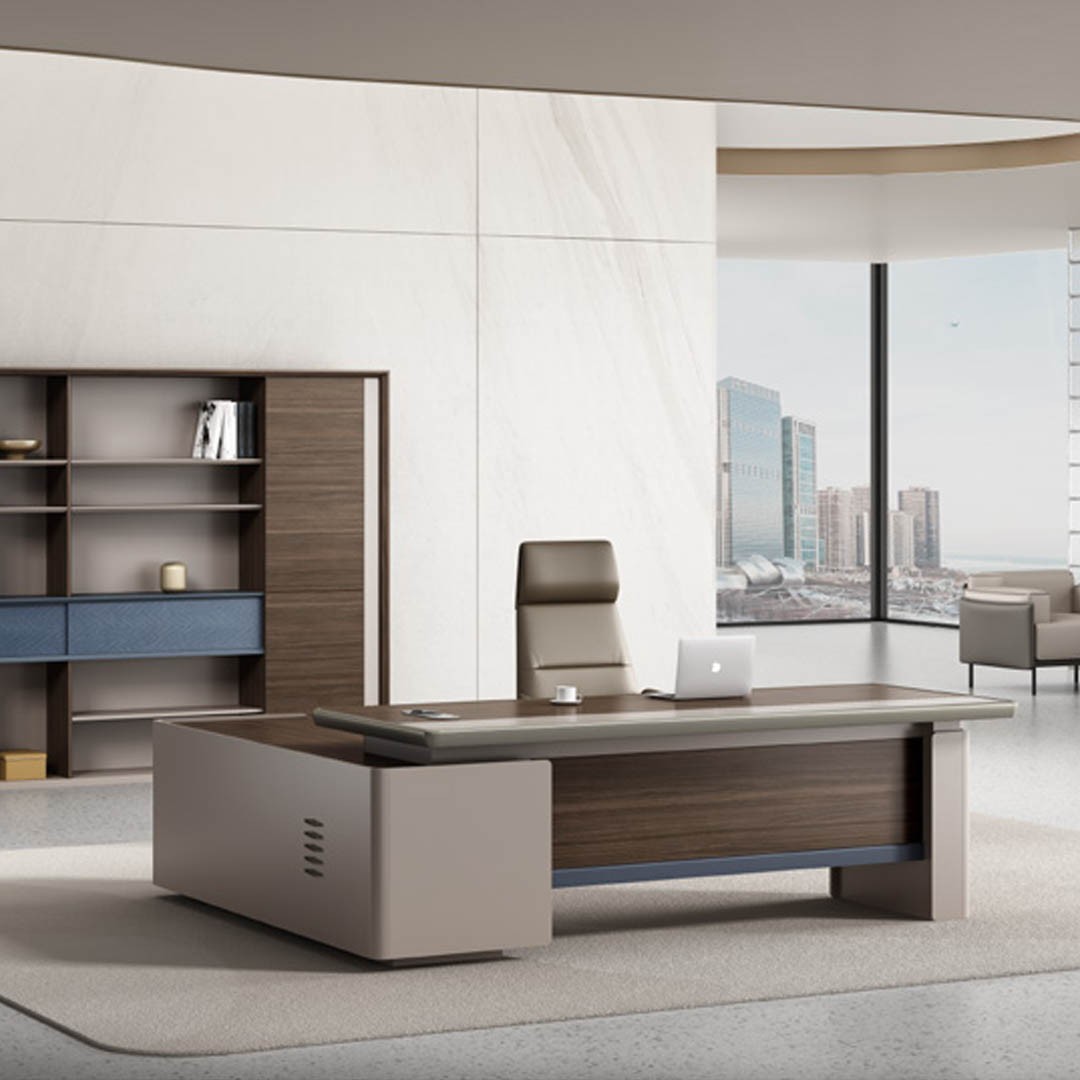
How to Choose the Right Desk for a Collaborative Workspace
Introduction
In today’s modern offices, collaborative workspaces have become essential for encouraging teamwork, communication, and efficiency. However, achieving a seamless and productive collaborative environment goes beyond choosing the right furniture for your space. The desk you choose plays a pivotal role in supporting team interaction, ensuring comfort, and maximizing productivity. Whether you're designing an open office, a shared workspace, or a conference area, the right desk can foster creativity and smooth collaboration. In this guide, we'll explore the key factors to consider when selecting a desk for a collaborative workspace.1. Desk Layout and Shape
For a collaborative workspace, the layout of your desks is crucial. L-shaped desks, such as the Ziyo Series L-Shape Luxury Office Desk or Siboon Series Ace Luxury L-Shape Executive Office Desk, are ideal for creating fluid, flexible environments. These desk designs offer ample space for multiple team members while allowing for easy communication across workstations. The L-shape also makes it easy to accommodate both individual tasks and group discussions without compromising on comfort or functionality.
2. Adjustable Heights for Flexibility
As collaborative work often requires different types of interaction—whether it's sitting, standing, or even working on different projects—height-adjustable desks are a key feature to look for. These desks enable employees to easily transition between sitting and standing positions, promoting better posture and reducing fatigue. Adjustable desks foster flexibility in how teams work, allowing each person to find the most comfortable position for collaboration.
3. Storage Solutions for Shared Workspaces
When designing a collaborative workspace, it's important to choose desks that offer integrated storage solutions. Drawers, shelves, or filing cabinets help keep the workspace organized and clutter-free. The Siboon Series desk features built-in storage to keep documents and materials within reach, preventing distractions and maintaining a tidy work area.
4. Collaborative Workspace Design Elements
Choose desks that support open communication and face-to-face collaboration. Consider desks with rounded corners or modular configurations that encourage team members to gather around easily. This layout helps break down barriers, both literally and figuratively, creating a space where everyone feels comfortable sharing ideas and working together.
5. Materials for Durability and Style
Durable materials, such as high-quality wood or metal, ensure that your desk will withstand the demands of a collaborative environment. Additionally, choose desks with sleek finishes or modern aesthetics that fit into your office design. The Ziyo Series L-Shape Desk features elegant materials that complement various office decors while offering the functionality needed for a busy team.
6. Cable Management for Clean Spaces
With multiple team members often working in close proximity, cables from computers, phones, and other devices can quickly become a tangled mess. Look for desks with built-in cable management features that allow you to organize and hide wires. This not only helps maintain a clean and tidy workspace but also reduces distractions and the risk of accidents.
7. Desk Size and Space Optimization
When selecting a desk for a collaborative workspace, consider the available space and how many people will use the desk. A larger desk may be needed for teams working together on complex tasks, while smaller desks may be better suited for informal meetings or individual workstations within the collaborative environment. Choose desks that can accommodate multiple people comfortably without overcrowding the space.
8. Mobility for Flexible Configurations
In collaborative spaces where team sizes and project needs may change frequently, desks with wheels or casters offer flexibility in terms of layout. Movable desks can be rearranged to accommodate different group sizes or project requirements. Opt for desks with high-quality, lockable wheels to ensure stability when in use.
9. Acoustic Considerations for Noise Control
While collaboration is key, noise levels can quickly become disruptive. Choose desks that offer noise-reducing features or pair them with acoustic panels and partitions to ensure a balanced work environment. This will allow teams to collaborate effectively without the distractions of unnecessary background noise.
10. Ergonomic Features for Comfort
Collaboration requires hours of sitting and working together, which can lead to discomfort and reduced productivity without the right ergonomic features. Ensure that desks offer enough legroom, and that chairs are adjustable to complement the desk's height. Ergonomically designed desks, like the Siboon Series and Ziyo Series, ensure comfort for long meetings or project sessions, allowing team members to focus on the work at hand.
Additional Considerations When Choosing a Desk for a Collaborative Workspace
11. Team Size and Desk Configuration
Consider the number of people who will use the desk regularly. Larger desks or modular setups may be required for bigger teams, while smaller teams may benefit from desks with compact designs.
12. Aesthetics and Office Branding
The desks should align with your office’s brand and overall aesthetic. Choose furniture that complements the color scheme, style, and atmosphere you wish to create for your collaborative space.
13. Multi-Use Features for Flexibility
Desks that support dual purposes, such as collaboration and individual work, help accommodate a variety of tasks. Consider desks with versatile surfaces that can be used for brainstorming sessions or casual meetings.
14. Support for Technology Integration
Modern collaborative teams often rely on technology. Look for desks that can accommodate monitors, laptops, or interactive displays. Tech-friendly desks support teams with charging stations, docking ports, or built-in technology integration.
15. Personalization and Comfort
Ensure that the desks allow for some degree of personalization, whether through adjustable seating or customizable desk layouts. This promotes ownership of workspace and comfort, which can improve overall productivity.
16. Environmental Considerations
Sustainability matters in office design. Choose desks made from eco-friendly materials or certified for sustainable production to help your organization reduce its environmental impact.
17. Space for Collaboration Tools
Collaboration tools such as whiteboards, pinboards, or display screens need to be considered when designing collaborative desks. Look for desks that allow easy integration of these tools to enhance teamwork.
18. Access to Natural Light
Where possible, select desks that maximize access to natural light. Natural light helps improve mood, focus, and well-being, contributing to a positive collaborative workspace.
19. Desk Maintenance
Consider the ease of maintaining the desk, particularly in a shared environment. Desks that are easy to clean and maintain will ensure longevity and continued functionality, minimizing downtime due to wear and tear.
20. Cost vs. Longevity
While it may be tempting to choose inexpensive desks, consider the long-term investment. A higher-quality desk may come at a higher cost but offers durability, features, and long-term value.
Recommended Products

-
Ziyo Series L-Shape Luxury Office Desk
This elegant L-shaped desk offers ample workspace and integrated storage, perfect for collaborative settings. Its luxurious design and functionality make it a great choice for a professional office environment.
-
Siboon Series Ace Luxury L-Shape Executive Office Desk
With its sleek, executive design, the Siboon Series desk combines style and practicality. It features generous surface area and efficient storage, making it ideal for collaborative teams.
Final Thoughts
Selecting the right desk for a collaborative workspace is crucial for optimizing communication and productivity. Desks that offer flexibility, ergonomic design, ample storage, and sleek aesthetics will not only support the team’s workflow but also enhance the overall office environment. By considering your workspace layout, team needs, and long-term goals, you can choose a desk that fosters collaboration and drives success in your office.FAQ
What is the best desk shape for a collaborative workspace?
L-shaped desks are ideal for collaborative workspaces as they offer ample surface area for multiple users and encourage communication between team members.Are adjustable desks important in a collaborative setting?
Yes, adjustable desks offer flexibility, allowing team members to choose the best working posture, whether sitting or standing.What should I look for in a desk for a shared workspace?
Look for desks with ergonomic features, adjustable height, ample storage, and a design that encourages easy interaction among team members.How can I ensure my desk fits my office layout?
Consider the size of the room, the number of people using the desk, and the space needed for other collaborative tools when selecting a desk for your office.


